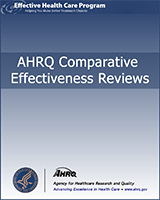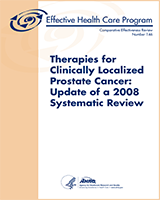NCBI Bookshelf. A service of the National Library of Medicine, National Institutes of Health.
Wilt TJ, Shamliyan T, Taylor B, et al. Comparative Effectiveness of Therapies for Clinically Localized Prostate Cancer [Internet]. Rockville (MD): Agency for Healthcare Research and Quality (US); 2008 Feb. (Comparative Effectiveness Reviews, No. 13.)

Comparative Effectiveness of Therapies for Clinically Localized Prostate Cancer [Internet].
Show details- 1)
Incidence of prostate cancer—the number of new cases per 100,000 age standardized male population during a given period of time
- 2)
Prostate cancer screening—proportion of males who reported PSA testing at the state level
- 3)
Mortality in patients with prostate cancer—all cause and prostate cancer deaths/100,000 age standardized male population during a given period of time
- 4)
Treatment utilization—rate of radical prostatectomy per 100,000 age adjusted male population; percent of patients with localized prostate cancer receiving radical prostatectomy, external beam therapy, brachytherapy, primary androgen deprivation therapy, radiation, and watchful waiting as a primary treatment of prostate cancer
- 5)
Intrahospital mortality—crude and adjusted death rate from all causes during hospitalization and 30 days after submission in patients with prostate cancer treated with radical prostatectomy
- 6)
Followup mortality—crude and adjusted death rate from all causes during the time of followup (90 days from surgery, 10 years from surgery) in patients with prostate cancer treated with radical prostatectomy
- 7)
Positive surgical margins—proportion of the patients with extension of the tumor to the inked surface of the resected specimens
- 8)
Intraoperation complication—proportion of the patients who needed blood transfusion during the prostatectomy
- 9)
Volume of blood loss in ml. Postoperative complications—proportion of the patients with potentially life-threatening events during the 30 days after surgery in the following categories: cardiac, respiratory, or vascular events; the need for reoperation; bleeding; and other events including renal failure and shock
- 10)
Late urinary complications—proportion of the patients treated for bladder-neck obstruction, urethral or ureteral strictures, intestinal or vesical fistulas, pelvic abscess, or any complication that resulted in early, definitive treatment of incontinence
- 11)
Long-term incontinence—proportion of patients with symptoms of incontinence and the proportion of patients treated with corrective procedures, including periurethral injections of collagen or placement of an artificial urinary sphincter and other invasive procedures 24 months after prostatectomy
- 12)
Failure of cancer control—proportion of patients treated with adjuvant hormone ablative therapy including orchiectomy, LupronT, goserelin and diethylstilbestrol
- 13)
Length of hospital stay—number of overnight stays in the hospital
- 14)
Cost—total hospital discharge in patients with localized prostate cancer in dollars
- 15)
Readmission rate—proportion of patients who were readmitted to the hospital within 30 days after the operation
- 16)
Operation quality indicators to assess radical prostatectomy specimens included: submission of a frozen section location of the adenocarcinoma, proportion of specimen involved by adenocarcinoma, perineural involvement, vascular involvement, seminal vesicle status, periprostate fat status, number of nodes submitted, status of nodes, and PIN (prostate intra-epithelial neoplasia)
- Definitions of Outcomes - Comparative Effectiveness of Therapies for Clinically ...Definitions of Outcomes - Comparative Effectiveness of Therapies for Clinically Localized Prostate Cancer
Your browsing activity is empty.
Activity recording is turned off.
See more...
